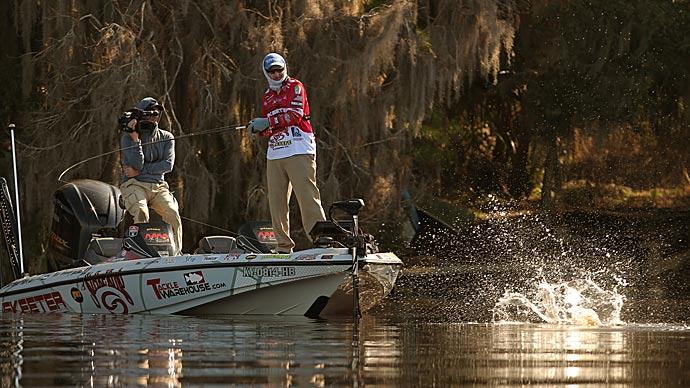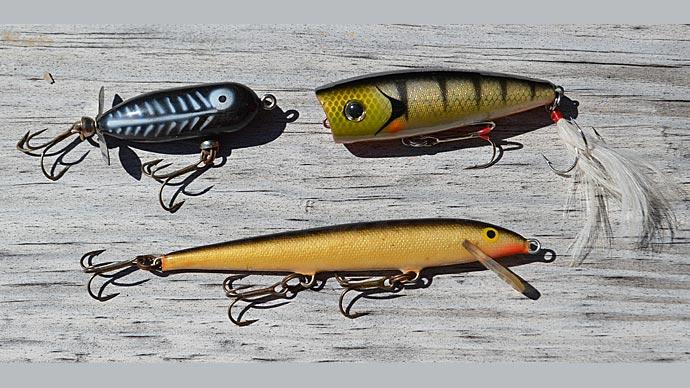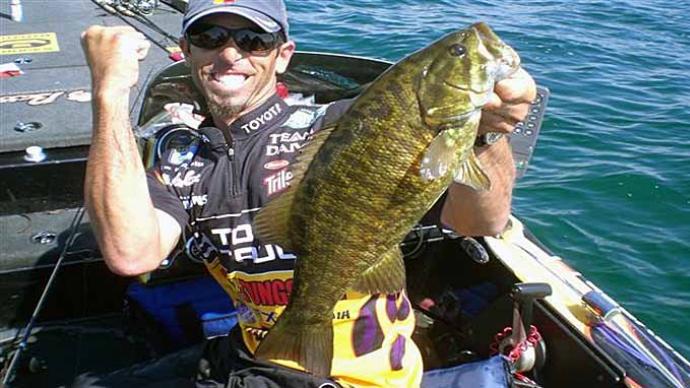
I was searching through the pockets of an old fishing jacket when I rediscovered the small box. The overlooked lure had never been out of the case, despite my original intentions to spend time testing it. My initial inspiration to purchase one at the local tackle store had occurred several months earlier. I had watched as a television fishing host had effectively shown the "jerk bait" to be a neglected but productive approach to connecting with shallow water bass. The printing on this particular box declared it to be a "Rapala Husky Jerk"; model HJ12 - a suspending jerk bait.
The trouble with trying something you have never fished before is finding the ideal time to experiment. Most anglers make the mistake of waiting until nothing else is working and then in desperation try out the new lure while the fish are turned down. But the best time is when your confidence baits have indicated the fish are active. And since the fish had been biting all morning, I opened the package and tied on the jerk bait.
Unlike the traditional balsa minnows that are light, run just under the surface, and float up quickly on the pause, this heavy cousin sailed when airborne. The first few jerks brought the small lipped minnow into that 3-4 foot range and when I paused, it just sat there motionless.
It took me a few casts to get a rhythm down: jerk, jerk, pause. Quickly I discovered the key was to crank the handle while you jerk the rod down toward the water. Equally important was letting the rod snap back up, creating a little slack line, which allows the bait to glide off to the side like an injured baitfish. I was pleasantly surprised with my initial attempts, because I had expected it to be much harder to make the bait dart and look enticingly vulnerable. It took a little concentration, but I was delighted with the lure's dancing, even in the hands of a beginning choreographer.
On my fifth cast, I was so intently focused on producing the proper cadence, that when the rhythm stopped unexpectedly, I suspected that I had done something wrong. But when a bronze torpedo exploded on the surface of the water with my Husky Jerk in it's mouth, my stunned brain snapped back into gear and the battle was on.
After weighing and releasing the healthy smallmouth, I picked up the jerk bait with a new found respect. It only takes one fish to fall victim to a new lure to boost the angler's confidence sky-high. Enough fish have fallen prey to that same jerk bait over the last several years that it is now one of my most treasured shallow water techniques.
My records indicate that early spring to post spawn, and again in the fall, seem to be the best times. And yet, I have caught both smallies and largemouth throughout the summer. Because bright light reflects well off the sides of the jerk bait as it darts around, sunny days seem to produce better than on cloudy days. The ideal situation is clear water and a bright day with just a little breeze rippling the surface. And when it works, it will produce throughout the entire day.
The jerk bait's greatest advantage is in its ability to stay in the "strike zone" longer. I am convinced that the attracting quality of an injured baitfish is second to none. And when it just stops and lies motionless, it is often more than a bass can resist. That same fish may not be willing to run down a spinnerbait or a lipless rattling crankbait, but an easy meal like the jerk bait can be just too good to pass up.
When the fish are active, I have caught bass with a fast retrieve that consists of continual short hard jerks. But the most consistent producer is a retrieve that includes two short 12-inch movements, followed by a two-second pause. The majority of hits occur on the pause. Occasionally a fish will follow this retrieve right up to the boat and turn away. That's when an extra long pause of 5-6 seconds, occurring two to three times throughout each cast, can make all the difference.
I've used both spinning and bait casting rods successfully. The key is to have a shorter rod, 51/2 to 6 feet, with a fairly light action. If the rod is too stiff or the line is too heavy, the preferred "springy" action is lost. In spinning I prefer the G. Loomis blank in the SJR 722 or 723 model, and in baitcasting the CR722 or 723 model. Since I snap the rod down most of the time, the shorter rod has its advantages. However, if I fish from the front of a boat with a higher casting platform, (such as an aluminum Lund), my 6' 2" height allows me to use a longer rod, (61/2 to 7 foot), but it must still have a fairly light action. The longer rods have an advantage in that they allow a little more casting distance, (which is important in clear water), but can be harder to jerk downward without hitting the water or side of the boat.
8- to 12-pound test line seems to work well. If I use a baitcasting rod I prefer a monofilament line. Braided lines tend to dig in on baitcasters not specifically designed for it when "jerking", occasionally snapping the lure back during the next cast. However braided line works well with the spinning gear, and the low stretch of the braided line requires less wrist snap to get the same action. If you have to cast into the wind, the spinning gear can reduce your frustration of having to deal with "professional overruns."
The Husky Jerk comes with a split ring attached, which prevents the action from being dampened, (such as occurs when you tie directly to the eye.) I use a snap to attach to the split ring and this seems to work well.
The Husky Jerk comes with three fairly sharp hooks, but they don't stay that way long. There is nothing more disheartening than to watch a nice fish break water and toss your offering back to the pitcher's mound. I've solved that problem by replacing the factory hooks with quality GamaKatsu EWG (Extra Wide Gap) Trebles. Warning: once you have done this, don't let the jerk bait brush your pants, coat, or any garment you do not want the lure permanently attached to. But more importantly, in the mouth of a head-shaking bass, the heavier 4¾-inch Rapala can do some serious snapping around. Therefore the hook needs to be buried quick and deep if it is to stay put. Sharp hooks make all the difference.
I always expected a jerk bait strike to be a violent experience. But the majority of times there is no train-smashing, wrist-cracking strike. Usually the lure just stops moving rhythmically and the line gets heavy. Because of the number and sharpness of the hooks, there is no reason to try and cross their eyes. The fish usually hook themselves, but a gentle sweep backwards can assist in this process. Horsing the fish will usually result in cursing or mumbling over "the one that got away." Play it nice and easy, and beware of a mouth full of sharp hooks when you try to lip the fish.
Use the jerk bait around long slow sloping points, over shallow flats, along weed edges, pilings, and for summer dock patterns. Whereas color is the least of the factors to be concerned with, the jerk bait with silver sides and a black back works well when the water is clear, and the fire-tiger pattern is preferred when the water is stained. (If the water is muddy, use something else.) The real key is in the action the angler produces in the bait.
We all have a few confidence baits that produce fish. But if an angler is smart, he or she keeps experimenting with other techniques, and adding to their "fishing tool box." The jerk bait is an excellent tool that can fill an important gap in our arsenal. Next to topwater, it's one of the most exciting lures to fish. It's easy to master, and it puts fish in the livewell. Buy a couple of jerk baits, but don't leave them in your pocket, or you'll miss out on some great fishing.



